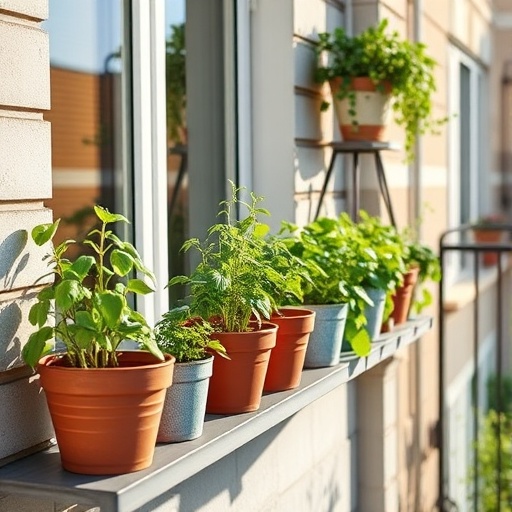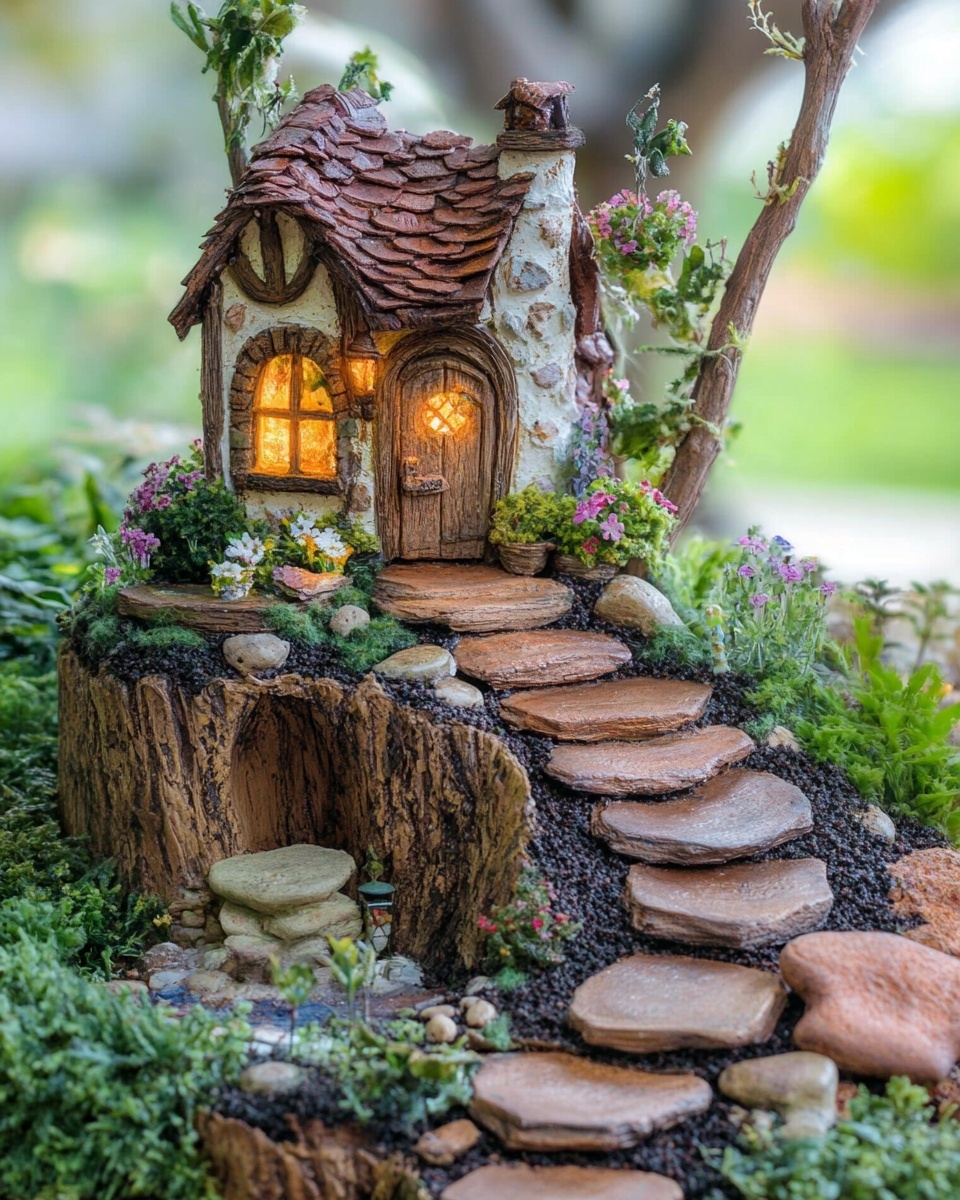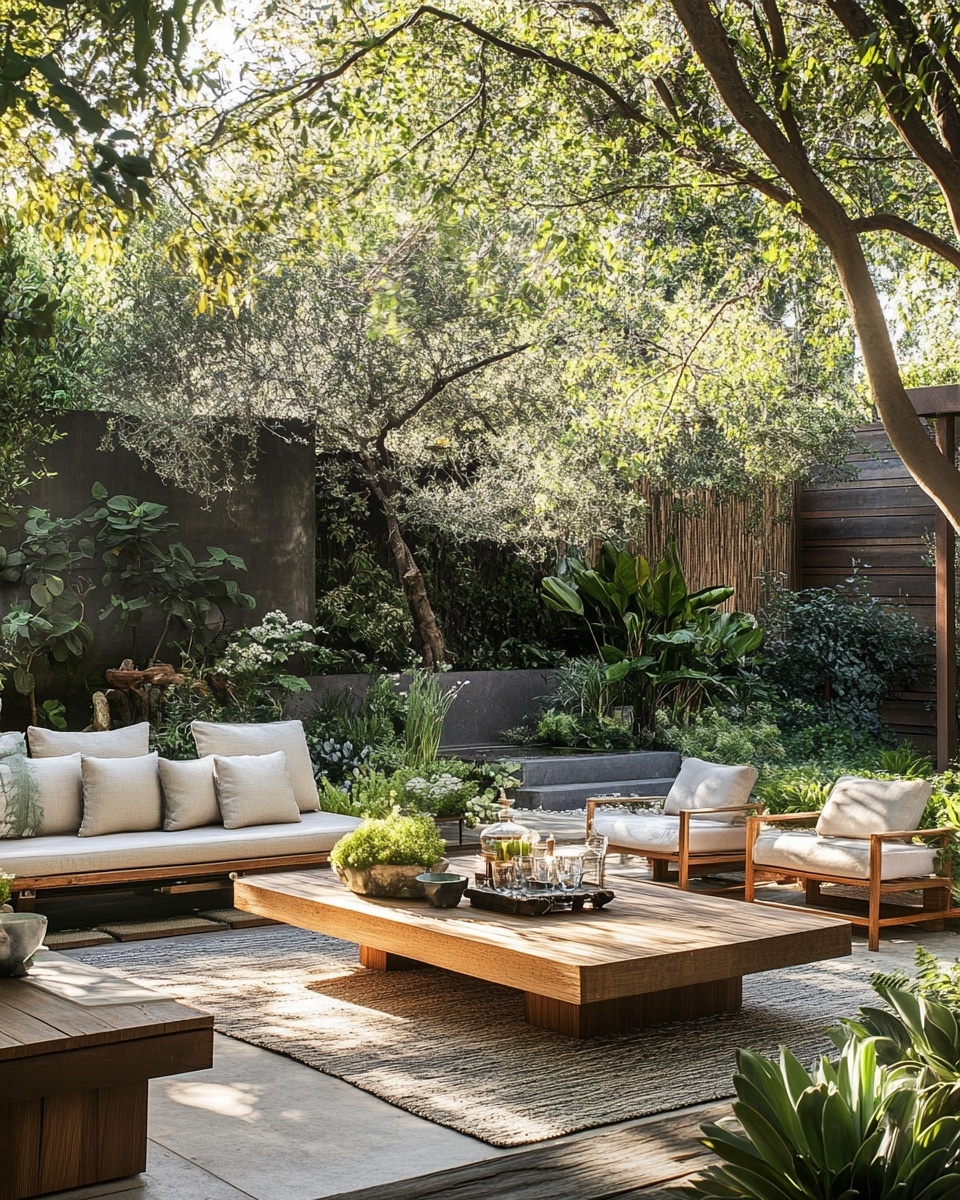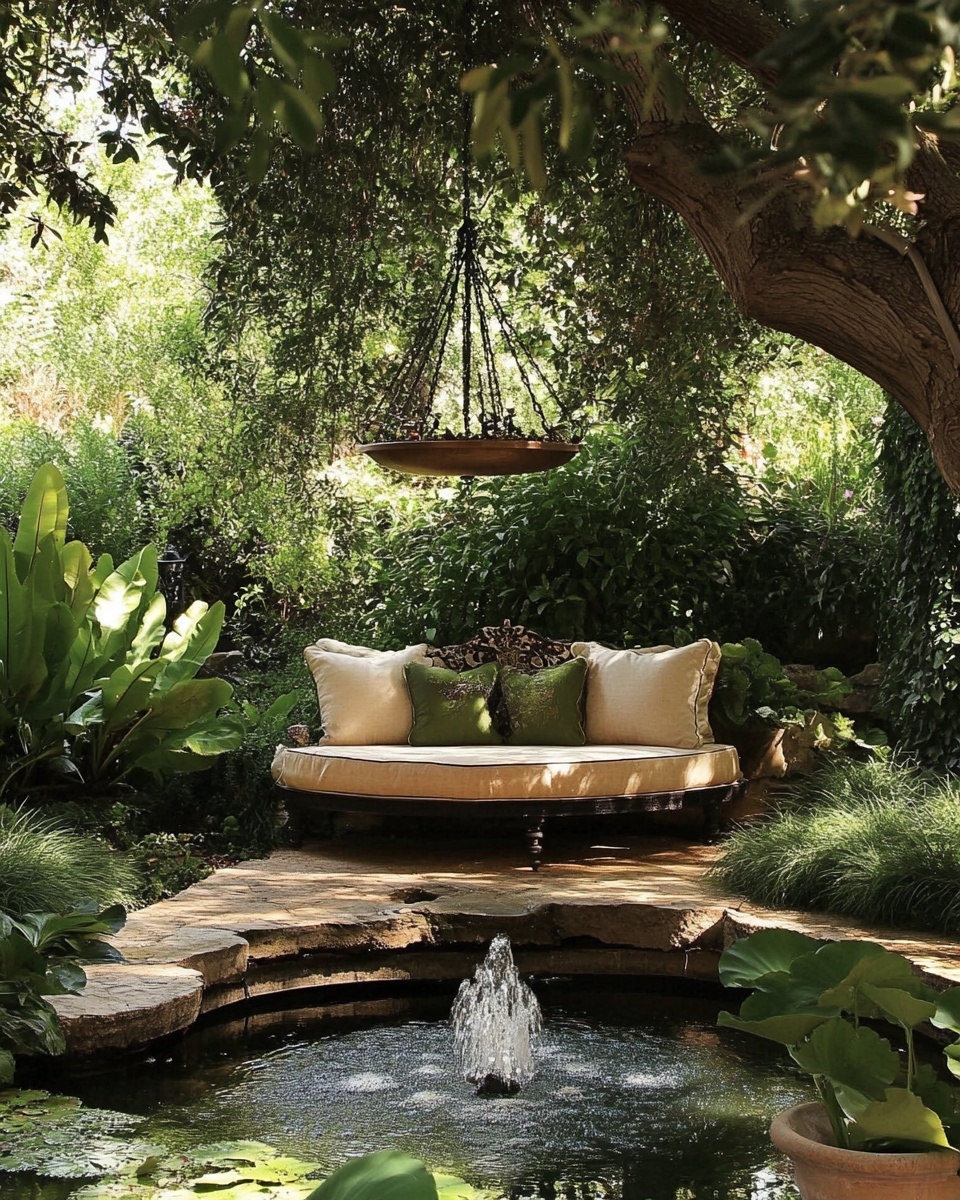Introduction
Did you know that over 80% of urban dwellers crave more greenery in their lives, yet often feel constrained by limited space? Transforming a small patch of concrete into a flourishing balcony herb garden for apartments isn't just a dream – it’s a tangible reality that can significantly enhance your quality of life. Imagine stepping out onto your balcony just before dinner, snipping fresh basil or fragrant rosemary, and bringing those vibrant flavors straight to your plate. This concept challenges the common belief that abundant green space is a prerequisite for a thriving garden, proving that even the most compact urban dwelling can become a sanctuary of fresh herbs.
Tools & Materials Needed
Embarking on your balcony herb garden journey requires a few key items, but don't worry, you don't need a massive investment. Here's what you'll need to get started:
- Pots and Planters: Start with various sizes. Terracotta pots are excellent for herbs like rosemary and thyme that prefer drier soil, as they allow for better air circulation and moisture evaporation. For moisture-loving herbs like mint and parsley, glazed ceramic or plastic pots work well. Consider vertical planters for maximizing space, or railing planters to free up floor area. For budget-friendly options, repurpose old plastic containers, tin cans (just be sure to drill drainage holes!), or even old tires.
- Quality Potting Mix: This is crucial! Don't just grab any soil. Look for an organic potting mix specifically designed for containers. It should be light, well-draining, and rich in organic matter. A good mix often contains compost, perlite, or vermiculite to ensure proper aeration and moisture retention.
- Herb Seeds or Starter Plants: For beginners, starter plants are a fantastic way to ensure success. They've already germinated and are past their most delicate stage. Some popular, easy-to-grow herbs include basil, mint, chives, parsley, and rosemary. If you're feeling adventurous, try seeds!
- Small Trowel or Hand Shovel: Essential for scooping soil and planting.
- Gardening Gloves: Protect your hands from dirt, thorns, and potential irritants.
- Watering Can with a Fine Rose: Gentle watering prevents dislodging seeds or young plants.
- Pruning Shears/Scissors: For harvesting and regular plant maintenance.
- Optional: plant labels, soil moisture meter, organic liquid fertilizer.
- Eco-friendly Alternative: Instead of buying new plastic pots, consider using biodegradable grow bags or making your own newspaper pots for starting seeds. Collect fallen leaves and kitchen scraps (vegetable peels, coffee grounds) to create a mini-compost for nutrient-rich soil amendments.
Time & Effort Overview
Starting a balcony herb garden for apartments is surprisingly time-efficient, making it perfect for busy urbanites. Initial setup, including potting your herbs, will likely take 1-2 hours, depending on the number of plants. Compared to growing vegetables from seed, which can take weeks to sprout, most herbs from starter plants establish quickly, often showing new growth within a week. Maintenance is relatively low:
- Daily Check: 5 minutes for watering, especially during hot weather.
- Weekly Check: 15-20 minutes for pruning, pest inspection, and general care.
- Monthly Check: 30 minutes for fertilizing (if needed) and more extensive pruning.
This is definitely a beginner-friendly project. The satisfaction you get from fresh herbs far outweighs the minimal effort! Many common herbs like basil and mint grow significantly faster than typical garden vegetables, often providing harvestable leaves within 3-4 weeks of planting.
Step-by-Step Gardening Process
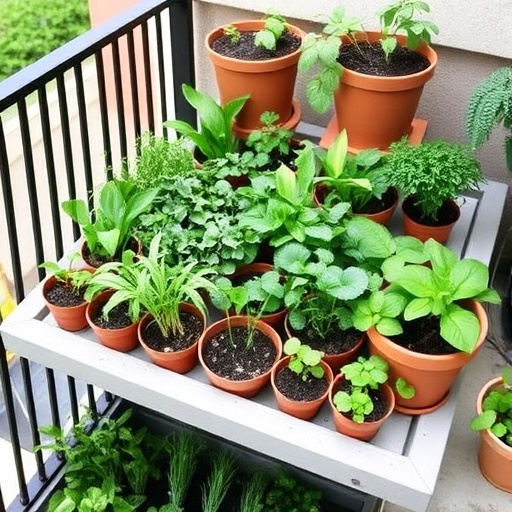
Ready to get your hands dirty? Here’s your straightforward guide to creating a thriving balcony herb garden.
1. Choose Your Herbs Wisely
Before anything else, select herbs that thrive in your balcony’s conditions. Consider sunlight exposure: does your balcony get full sun (6+ hours), partial sun (3-6 hours), or shade? For sunny balconies, consider basil, rosemary, thyme, oregano, and lavender. For partial sun, mint, parsley, chives, and cilantro often do well. Don't worry if your balcony is mostly shady; you can still grow herbs like parsley, cilantro, and mint that tolerate less light.
2. Select the Right Containers
Good drainage is non-negotiable. Ensure all your pots have drainage holes at the bottom. If they don't, manually drill some before adding soil. The size of the pot matters too; a standard 6-inch pot is suitable for most single herb plants, but larger herbs like rosemary or multiple smaller herbs will need bigger containers (8-10 inches or more).
3. Prepare Your Potting Mix
Fill your chosen pots with a high-quality, well-draining organic potting mix. Avoid garden soil, as it compacts easily in pots and can harbor pests or diseases. Leave about an inch of space from the rim of the pot to allow for watering without overflow.
4. Plant Your Herbs
If using starter plants: Gently remove the herb from its nursery pot, loosening any circling roots at the bottom. Dig a hole in your prepared potting mix large enough to accommodate the root ball. Place the plant in the hole, ensuring the top of the root ball is level with the soil surface, and backfill with potting mix.
If planting seeds: Follow the instructions on your seed packet for planting depth and spacing. Generally, a good rule of thumb is to plant seeds at a depth twice their diameter. Cover lightly with soil and mist gently.
5. Water Thoroughly
Immediately after planting, water your herbs thoroughly until water drains from the bottom of the pot. This helps settle the soil around the roots. Don’t worry if some soil splashes out; just gently pat it back down.
6. Provide Initial Care and Label
Place your newly planted herbs in their designated spots on the balcony according to their light requirements. Add plant labels to keep track of what you’ve planted, especially if you’re new to herb gardening. This little step saves a lot of guesswork later on!
Growth & Care Tips
Consistent care ensures your balcony herb garden for apartments flourishes. Here's how to keep your herbs happy and healthy:
- Watering Frequency: This is where many go wrong. The general rule is to water when the top inch of soil feels dry to the touch. This could be daily in hot, sunny weather or every few days during cooler periods. Overwatering is a common killer, leading to root rot. Underwatering causes wilting. Scientific studies show that soil moisture meters can reduce overwatering instances by up to 40% for beginner gardeners.
- Sunlight Exposure: Most herbs crave at least 6 hours of direct sunlight. If your balcony is shadier, consider light-loving herbs like mint or cilantro, or use supplementary grow lights during shorter, darker days. Even a few hours of morning sun can make a big difference.
- Pruning for Bushiness: Regular pruning isn't just for harvesting; it encourages bushier growth and prevents your herbs from becoming leggy. Snip off the top few sets of leaves just above a node (where leaves branch off the stem). For basil, pinching off flower buds will extend its leafy production.
- Fertilization: Potted plants deplete soil nutrients faster than in-ground plants. Feed your herbs with a diluted organic liquid fertilizer every 2-4 weeks during the growing season (spring through fall). Avoid over-fertilizing, which can burn roots.
- Pest Prevention: Inspect your herbs regularly for signs of pests like aphids or spider mites. A strong spray of water can dislodge many pests. For persistent issues, use an organic insecticidal soap or neem oil solution. Early detection is key to preventing infestations. Did you know that early intervention against common herb pests can save up to 70% of affected plants?
Eco-Friendly & Sustainable Alternatives
Making your balcony herb garden for apartments sustainable is both rewarding and easy.
- Composting: Start a small vermicompost bin or a simple DIY compost bucket with kitchen scraps (fruit/veg peels, coffee grounds, eggshells) and dried leaves. This "black gold" is a nutrient powerhouse for your plants.
- Natural Fertilizers: Beyond your homemade compost, consider options like kelp meal, worm castings, or diluted compost tea. These provide a slow release of nutrients and improve soil health without synthetic chemicals.
- Water Conservation: Implement drip irrigation or self-watering pots to reduce water waste. Collect rainwater in a small barrel or bucket to use for watering. Mulching the top of your pots with straw or small stones can help retain soil moisture, reducing the need for frequent watering.
- Alternatives for Small Spaces:
- Vertical Gardens: Wall-mounted planters, repurposed shoe organizers, or pallet gardens are excellent for maximizing vertical space.
- Tiered Planters: Pots stacked on top of each other create multiple growing levels in a small footprint.
- Railing Planters: Hang planters directly on your balcony railing, keeping floor space clear.
- DIY Recycled Containers: Get creative with old plastic bottles (cut them in half, invert the top with a wick), coffee cans, or wooden crates. Ensure proper drainage holes are added. Check out {"loc":["https://pincraftpro.com/diy-balcony-herb-garden-with-recycled-containers/"],"lastmod":["2025-10-11T18:29:54+00:00"],"image:image":[{"image:loc":["https://pincraftpro.com/wp-content/uploads/2025/10/step-by-step-DIY-Balcony-Herb-Garden-with-Recycled-Containers.jpeg"]}]} for more ideas!
Creative Ideas & Uses
A balcony herb garden for apartments isn't just functional; it's a statement! Unleash your inner designer:
- Aesthetic Combinations: Mix various herbs with cascading edible flowers like nasturtiums or violas for a beautiful and delicious display. Consider pairing herbs with contrasting leaf textures (e.g., feathery dill next to broad-leaf basil) for visual interest.
- Repurpose & Decorate: Old wooden ladders can become tiered plant stands. Mason jars can hold freshly cut herbs or small, single plants (with drainage added!). Paint your pots in vibrant colors or soothing pastels to match your balcony decor. You can even use small, decorative pebbles or sea glass as mulch on top of the soil for an aesthetic touch.
- Design Inspirations:
- Mediterranean Oasis: Group terracotta pots with rosemary, thyme, lavender, and oregano. Add some small olive branches or a miniature citrus plant for the full effect. This design works exceptionally well on sunny balconies.
- Culinary Corner: Focus on herbs used frequently in your cooking. Think basil, parsley, cilantro, chives, mint, and oregano, easily accessible from your kitchen door.
- Vertical Green Wall: Install a vertical planter system and fill it with a variety of herbs. This creates a stunning living art piece and maximizes growing space. For more on vertical gardening, explore {"loc":["https://pincraftpro.com/vertical-balcony-herb-garden-design-ideas/"],"lastmod":["2025-10-12T00:38:16+00:00"],"image:image":[{"image:loc":["https://pincraftpro.com/wp-content/uploads/2025/10/step-by-step-Vertical-Balcony-Herb-Garden-Design-Ideas.jpeg"]}]}.
- Beyond the Kitchen: Many herbs, like lavender and lemon balm, are fantastic for aromatherapy or making homemade teas and potpourri. Basil and mint can be used to infuse water or cocktails.
Common Mistakes to Avoid
Even seasoned gardeners make mistakes! Here are some common pitfalls in a balcony herb garden for apartments and how to sidestep them:
- Overwatering: As mentioned, this is the number one killer. Overwatering causes root rot in over 60% of houseplants and potted herbs. Always check the soil moisture before watering. When in doubt, wait a day. {"loc":["https://pincraftpro.com/how-to-water-balcony-herbs-without-overwatering/"],"lastmod":["2025-10-11T16:29:46+00:00"],"image:image":[{"image:loc":["https://pincraftpro.com/wp-content/uploads/2025/10/step-by-step-How-to-Water-Balcony-Herbs-without-Overwatering.jpeg"]}]} gives you an in-depth guide.
- Insufficient Drainage: Pots without holes mean water sits and suffocates roots. Always use pots with drainage holes, and if repotting, ensure they don't get blocked.
- Too Small Pots: As herbs grow, their roots need space. Cramped roots stress the plant, leading to stunted growth or premature flowering. Repot into a larger container when roots start to show at the drainage holes.
- Wrong Sun Exposure: Placing sun-loving herbs in shade, or shade-tolerant herbs in scorching full sun, will lead to unhappy plants. Research each herb's specific needs before planting.
- Neglecting Pruning: While it might feel counterintuitive to snip off healthy growth, neglecting pruning leads to leggy, unproductive plants. Regular pinching encourages vigorous, bushy growth.
- Ignoring Pests: A small pest problem can quickly escalate into a full-blown infestation if ignored. Early intervention is crucial. Inspect your plants regularly and act at the first sign of trouble.
Maintenance & Storage Tips
Ensuring long-term vitality for your balcony herb garden for apartments involves ongoing care and smart harvesting:
- Long-Term Plant Health:
- Repotting: As your herbs grow, they will eventually become root-bound. Plan to repot them into slightly larger containers every 1-2 years, or refresh the soil with new potting mix while keeping the same size pot.
- Seasonal Care: In colder climates, bring tender herbs like basil indoors before the first frost or provide protection. Hardier herbs like rosemary and thyme can often overwinter on a sheltered balcony.
- Addressing Yellow Leaves: Yellow leaves often indicate overwatering, nutrient deficiency, or sometimes natural aging. Check soil moisture first. If the soil is dry, consider a gentle dose of fertilizer.
- Poor Soil Drainage: If water sits on top of your soil or drains too slowly, it's likely compact. Gently aerate the soil with a chopstick or thin stick, or consider repotting with fresh, well-draining mix.
- Harvesting and Storage:
- Harvesting: Always harvest herbs in the morning after the dew has dried for the best flavor. Use sharp scissors or pruning shears to snip off leaves or stems. Don't take more than one-third of the plant at a time to allow for regrowth.
- Fresh Storage: Store freshly cut herbs like a bouquet in a glass of water on your countertop, or wrap them in a damp paper towel and place them in a plastic bag in the refrigerator. This can extend their freshness for over a week.
- Drying: For long-term storage, bundle herbs like rosemary, thyme, or oregano and hang them upside down in a cool, dark, well-ventilated area. Once crisp, strip the leaves and store them in airtight containers.
- Freezing: Freezing is excellent for herbs like basil, parsley, and cilantro. Chop them finely and freeze them in ice cube trays with a little olive oil or water. Transfer the frozen cubes to freezer bags.
For detailed instructions on propagating herbs or moving them indoors for winter, you might find {"loc":["https://pincraftpro.com/how-to-grow-herbs-indoors-move-them-to-balcony/"],"lastmod":["2025-10-12T00:18:15+00:00"]} quite helpful!
Conclusion
Creating a vibrant balcony herb garden for apartments is more than just a hobby—it's an enriching experience that brings fresh flavors to your table, beauty to your space, and a touch of nature to your urban life. From understanding the right tools to mastering sustainable practices, you now have a comprehensive guide to cultivate a thriving herbal haven. The journey of transforming your balcony into a fragrant, edible escape is incredibly rewarding, offering both culinary delights and a serene retreat. So, what are you waiting for? Grab your trowel, choose your favorite herbs, and start planting today! Share your beautiful balcony herb garden photos with us on Pinterest at https://www.pinterest.com/janatjanay47/ and inspire others to get growing!
FAQ
Q1: What are the easiest herbs to grow in a balcony herb garden for beginners?
A1: For beginners, start with resilient herbs like mint, chives, basil, parsley, and rosemary. They are generally forgiving, grow vigorously, and don't require overly complex care, making them perfect for a first balcony herb garden for apartments.
Q2: How much sunlight does a balcony herb garden need?
A2: Most herbs, especially culinary ones, thrive with at least 6 hours of direct sunlight per day. However, some, like mint, parsley, and cilantro, can tolerate partial sun (3-4 hours) while still producing well.
Q3: How often should I water my balcony herbs?
A3: The watering schedule depends on several factors: weather, pot size, and herb type. A good rule of thumb is to check the soil daily; if the top inch feels dry, it's time to water thoroughly until it drains from the bottom. Avoid letting pots sit in standing water.
Q4: Can I grow herbs from seeds on a balcony?
A4: Absolutely! While starter plants offer a quicker start, growing from seeds is cost-effective and rewarding. Follow seed packet instructions for depth and spacing. Many beginner-friendly seeds germinate quickly, such as basil, cilantro, and dill.
Q5: What are common signs of an unhealthy herb plant, and how do I fix them?
A5: Yellowing leaves often indicate overwatering or nutrient deficiency. Wilting can mean underwatering or root rot. Brown, crispy edges typically point to underwatering or too much sun. Inspect for pests if you see chewed leaves. Adjust watering, provide appropriate light, and consider a diluted organic fertilizer to revive your plants.
Q6: What's the best soil mix for a balcony herb garden for apartments?
A6: A high-quality, well-draining organic potting mix is ideal. It should be light, airy, and contain amendments like perlite or vermiculite to prevent compaction and ensure proper root aeration, crucial for confined container growth.
Q7: How can I maximize space for my balcony herb garden on a small apartment balcony?
A7: Utilize vertical space with wall-mounted planters, hanging baskets, or tiered plant stands. Railing planters are excellent for freeing up floor space. {"loc":["https://pincraftpro.com/compact-balcony-herb-garden-layout-plan/"],"lastmod":["2025-10-11T20:29:50+00:00"]} offers more innovative ideas for compact layouts.
